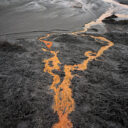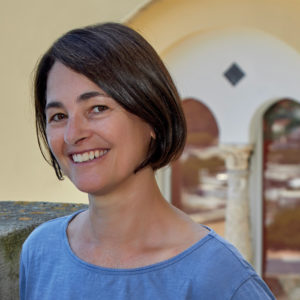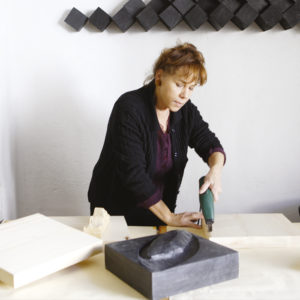La vita di Lawrence Carroll (1954–2019) è stata ricca di epifanie, tra cui una delle più importanti può essere così riassunta: per arrivare alla tela bianca bisogna prima perderla. Per molti artisti la tela grezza è una superficie da violare al fine di trovare un corpo all’immagine o alla materia, ma per altri il bianco-non-bianco del tessuto vergine parla più di qualsiasi segno che possa esservi apposto. La gradazione del bianco, il nitore, l’imperfezione nel filato del materiale, il vuoto e la sua maestosità espressiva, chiedono di essere sfidati anche da chi si sente pago di loro. Lawrence Carroll amava i materiali, specie quelli umili, che considerava pregni di “meaning”, significato; la sua ricerca ha tenuto conto sia dell’espressione intrinseca al fare, lo svolgersi delle azioni nello studio, sia di una necessità sentimentale ed estetizzante che in quelle azioni riversava intimità, memoria e luminosità accoglienti, dolorose, amorose, malinconiche. Una tela ripiegata su se stessa e accantonata in un angolo della stanza o una fotocopia macchiata accidentalmente di pittura, suggerivano a Carroll qualcosa di compiuto, come se gli strumenti del fare fossero già grevi di una poesia che non poteva essere ignorata.
Nato in Australia da una famiglia industriosa e creativa nella manutenzione degli elementi domestici, ancora bambino l’artista emigra con i genitori e i fratelli in California. A casa Carroll non si butta nulla, si aggiusta, e si costruiscono intere parti di edificio con le proprie mani; è tutto un via vai di toppe, rammendi, lavori di falegnameria e inaspettate soluzioni.
Negli anni Settanta studia all’Art Center College of Design di Los Angeles e successivamente insegna presso altri college di area californiana; in questo periodo, a causa delle condizioni economiche precarie, dipinge recuperando tele e telai dagli scarti altrui, assemblando queste rimanenze in una maniera inedita, basata sulle storie dei materiali e tesa alla rottura della supposta bidimensionalità del dipinto.
Si trasferisce a New York dove, intorno alla metà degli anni Ottanta, lavora come illustratore per il New York Times, il Village Voice e altri periodici; visita costantemente musei e gallerie; comprende che, più che in una strada, può trovare la propria voce a un bivio, quello che divide gli autori del minimalismo quali Donald Judd o Carl Andre dagli autori del primo e tardo espressionismo astratto, da Willem de Kooning a Jasper Johns. Per Carroll il dipinto è un oggetto che esige di essere osservato da ogni lato, non solo frontalmente; come nel minimalismo, l’opera d’arte chiede un coinvolgimento spaziale dello spettatore. Tuttavia, al pari che nell’espressionismo astratto, il dipinto è umano, estremamente fatto a mano, non è un progetto bensì un processo; è una stratificazione di ripensamenti che Carroll non cela ma evidenzia tagliando e poi assemblando nuovamente i propri supporti o creando superfici materiche attraverso il rapido graffettare una tela o una carta sull’altra.
Per diventare pittore, Carroll capisce che deve sacrificare il disegnatore. Un’altra fondamentale epifania occorre un giorno nello studio dell’artista: egli attacca le fotocopie delle proprie illustrazioni su una tela e le copre di un bianco simile a quello del tessuto originario, effettuando una cancellazione. Carroll scopre che si può tornare al bianco: esso non è solo origine e nettezza, può bensì essere anche esito e materia.
In decenni di pittura i giorni di rivelazione rilucono di una particolare felicità, Lawrence Carroll li ricordava tutti e non ne era mai sazio; continuò a inseguire e a bearsi di nuove scoperte fino all’ultima ora, integrandole anche nei lavori più tardi. C’era stato un giorno in cui aveva capito che la cera poteva accentuare la metafora organica sulla superficie del dipinto e un altro giorno in cui aveva applicato pittura sul pavimento sporco e vi aveva posizionato sopra un cencio imbrattato, inaugurando così l’uso del suolo. Una sera notò una piccola lampada che illuminava una porzione di quadro e da lì incorporò lampadine accese o fulminate come parti della composizione; un’altra sera gettò un viticcio d’edera su un’opera, e poi una scala, un fiore, una tela piegata. Tutto quello che la vita, o la vita nello studio, avvicinava al dipinto, trovava a proprio tempo spazio nel dipinto stesso. Più che una ricerca, quella di Lawrence Carroll è stata un lento succedersi di prime volte, perseguite ma inimmaginabili, giunte grazie alla vita.
Le serie di Carroll recano titoli altrettanto capaci di veicolare le qualità organiche, antropiche – per utilizzare un termine definitivo, mortali – dei dipinti: Box Paintings, Page Paintings, Stacked Paintings, Light Paintings, Calendar Paintings, Cut Paintings, Flower Paintings, Hand Paintings, Sleeping Paintings, Slip Paintings, Shadow Paintings, Ivy Paintings, Patch Paintings, Freezing Paintings, Tambourine Paintings, Object Drawings, Wave drawings, String Paintings, Table Paintings, Prop Paintings, Slide Paintings, Hinge Paintings, Newspaper Paintings, Yellow Paintings, Oval Paintings, Blue Paintings, Black Mirror Paintings, Cocoon Paintings, Magdeburg Paintings, Moment Paintings… Alla fine degli anni Ottanta la ricerca di Lawrence Carroll può dirsi matura e la sua fortuna comincia a costruirsi grazie anche all’interesse nutrito nei suoi confronti da curatori di grande pregio intellettuale, tra cui Tricia Collins e Richard Milazzo, Harald Szeemann, Jan Hoet, Denys Zacharopoulos, nonché collezionisti illuminati quali i coniugi Panza di Biumo.
Nel 1953 Robert Rauschenberg espone i White Paintings, tele montate su telaio e dipinte tramite rullo con uno strato di umile pittura bianca, quella usata per i lavori domestici. I dipinti, come sottolineò John Cage, erano privi di soggetto, tecnica, messaggio, intenzione, autorialità; riflettevano le caratteristiche cromatiche, spaziali, luminose della stanza che li ospitava. Un processo di estroversione, quello di Rauschenberg, che Carroll nelle proprie opere trasforma in introversione: il bianco riflettente diviene bianco assorbente. Assorbendo la gestualità dell’artista che cuce e ricuce brandelli di tela, taglia e cauterizza telai, imprigiona fiori e spande amidi, sporca il colore, lo bagna e lo ghiaccia, la pittura diviene un
lunghissimo taccuino.
Nel quotidiano Lawrence Carroll rigirava di continuo taccuini stropicciati, brandelli di giornale, parole che ritagliava qua e là, appunti presi su supporti di fortuna. La cronaca, i fatti, le storie che avvenivano fuori e dentro lo studio, lavorate nel pensiero e schiarite dalla luce, diventavano le stratificazioni di materia sui quadri di Carroll. A conclusione di un processo pittorico intenso quanto una vita, il dipinto si compiva là dove per altri sarebbe solo iniziato, nell’imperfetta e umile poesia del materiale.
The life of Lawrence Carroll (1954-2019) has been full of epiphanies, among which one of the most important can be thus summarized: if you want to reach the white canvas you must first lose it.
For many artists the empty canvas is a surface to violate in order to find a place for the image or materia yet for others the white and non-white of the virgin fabric itself speaks more than any mark that could be placed on it.
The gradation of white, the cleanliness, the imperfection in the yarn of the material, the emptiness and its expressive magnificence, demand to be challenged even by those who feel satisfied. Lawrence Carroll loved materials, especially the humble ones, which he considered impregnated with meaning; his research took into account both the intrinsic expression of action in the atelier and the sentimental and aesthetic necessity, that in those actions poured intimacy, memory and welcoming, painful, amorous, melancholic brightness. A canvas folded in on itself and abandoned in a corner of the room or a photocopy accidentally stained with paint, suggested to Carroll something accomplished, as if the tools were already rich with a poetry that could not be ignored.
Born in Australia from an industrious and creative family in the maintenance of domestic items, while he was still a child the artist moves with his parents and siblings to California. At the Carroll’s place nothing is thrown away, everything is repaired, and they build entire editions of their home with their own hands; a bustle of patches, mends, carpentry and unexpected solutions.
In the 1970s he studies at the Art Center College of Design in Los Angeles and later he teaches in other universities in California; during this period, due to the precarious financial situation, he paints using canvases and frames he has recovered from other people’s scraps, assembling these leftovers in an unusual way, looking for the stories behind the materials and aiming at breaking the supposed two-dimensionality of the painting.
He moves to New York where, around the mid-1980s, he works as an illustrator for the New York Times, the Village Voice and other magazines; he constantly visits museum and galleries; he understands that, more than on a single road, he can find his own voice at a crossroad, the one dividing the minimalist artists such as Donald Judd or Carl Andre from the artists of the first and late abstract expressionism, from Willem de Kooning to Jasper Johns. According to Carroll the painting is an object that demands to be seen from every side, not only frontally; just like in minimalism, the pieces ask for a spatial involvement by the observers. However, on par with abstract expressionism, the painting is human, extremely hand-made, it is not an object but rather a process; a stratification of afterthoughts that Carroll does not hide and instead highlights, cutting and then assembling again his own supports or creating material surfaces through rapid stapling the canvas or two sheets on each other.
In order to become a painter, Carroll understand that he must sacrifice the illustrator. Another fundamental epiphany occurs one day in his atelier: he attaches the photocopies of his illustrations on a canvas and he covers them with a white, similar to the one of the original canvas, performing a cancellation. Carroll discovers that he can go back to white: it is not only origin and cleanness; it can also be outcome and matter.
In decades of painting, the days of revelations illuminated Lawrence Carroll with a peculiar happiness, he remembered them all and he was never satisfied with them; he continued following and enjoying new discoveries up until the final hours, integrating them in later works as well. There was a day when he understood that wax could accentuate the organic metaphor of the painting’s surface and another day where he applied painting on the dirty floor and positioned a stained rag on top of it, thus inaugurating the use of soil. One evening he noticed a little lamp illuminating a section of a painting and he then incorporated lighted or blown out bulbs as parts of the composition; another evening he threw an ivy on a piece, and then a ladder, a flower, a folded canvas. Everything that has life, of life in the atelier, bring closer to the painting and found at their own time a space in the painting itself. More than a research, that of Lawrence Carroll was a slow sequence of first times, pursued yet unimaginable, achieved thanks to life.
Carroll’s series bear titles equally capable of conveying the organic, anthropic – to find a permanent definition, mortal – qualities of the paintings: Box Paintings, Page Paintings, Stacked Paintings, Light Paintings, Calendar Paintings, Cut Paintings, Flower Paintings, Hand Paintings, Sleeping Paintings, Slip Paintings, Shadow Paintings, Ivy Paintings, Patch Paintings, Freezing Paintings, Tambourine Paintings, Object Drawings, Wave drawings, String Paintings, Table Paintings, Prop Paintings, Slide Paintings, Hinge Paintings, Newspaper Paintings, Yellow Paintings, Oval Paintings, Blue Paintings, Black Mirror Paintings, Cocoon Paintings, Magdeburg Paintings, Moment Paintings…
At the end of the 1980s Lawrence Carroll’s research can be considered mature and his success begins (to grow) also thanks to the interest of curators of great intellectual fame, among which Tricia Collins and Richard Milazzo, Harald Szeemann, Jan Hoet, Denys Zacharopoulos, as well as enlightened collectors such as the Panza spouses in Biumo.
In 1953 Robert Rauschenberg exhibits the White Paintings, canvases assembled on a frame and painted by means of a roll with a layer of unpretentious white paint, the kind used in housework. These paintings, as John Cage highlighted, lacked subject, technique, message, intention, authorship: they reflected the chromatic, spatial, luminous features of the room hosting them. An extroversion process by Rauschenberg, which Carroll transforms into introversion: the reflecting white becomes an absorbing white. In absorbing the gestures of the artist who sews scraps of canvas, cuts and cauterizes frames, imprisons flowers and spreads starch, who soils the colors, soaks it, freezes it, the painting becomes a long notebook.
In his everyday life, Lawrence Carroll constantly wrote on crumpled notebooks, scraps of newspapers, words cut out here and there, notes taken on improvised supports. The news, facts, stories happening outside and inside the atelier, carved in thought and lightened by light, became layers of matter on his paintings. At the end of the pictorial process as intense as life, the painting was completed, where for others it might have just begun, in the imperfect and humble poetry of the material.








No Comments